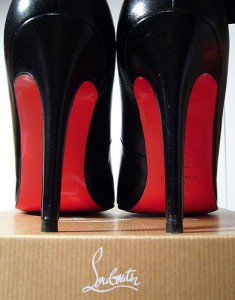Can You Trademark a Color?
Could Pablo Picasso sue Claude Monet for using his signature melancholy blue color? That question was raised this week by a federal judge in New York. The suit before the judge was not actually brought by Picasso. But it did involve a trademark in a color.
 Photo: valeyoshino
Photo: valeyoshinoAs his many fans know, Christian Louboutin is an artist of the foot. His shoes are widely revered (see songstress Jennifer Lopez’s ode, “Louboutins”) and not cheap: close to four figures in many cases, and sometimes more. Louboutin shoes also feature a well-known quirk: red soles. And when the venerable fashion house of Yves St. Laurent began selling red soled shoes recently, Louboutin—who had trademarked said soles in 2008—quickly sued.
The judge in this case did not doubt that Louboutin’s red soles fulfilled the fundamental purpose of trademark, which is to designate the source of a good. And colors have been successfully used as trademarks before—Owens Corning’s pink color for fiberglass insulation, for example, is trademarked.
But the general understanding in American law is that colors can only be trademarked if they serve—and only serve— to identify the source of a product. They cannot serve any other function. The interesting question here was whether enhancing beauty is an “other function,” such that red soles cannot be trademarked lest this unfairly inhibits competition. In other words, can aesthetics be functional?
To think this through, the judge analogized to a hypothetical dispute between Monet and Picasso over a particular shade of blue. As in fashion, he wrote, in painting, color is “an indispensable medium” of expression. To give control over a color to a single artist would both hinder art and harm competition. Likewise, reasoned the judge, a color cannot be monopolized by a single fashion designer.
Louboutin’s own declarations in the case, moreover, gave ammunition to the view that aesthetics can be functional. Louboutin declared that he chose red because it gave the soles “energy,” and was “sexy” and “engaging.” These seemed to the judge like functional attributes that made the product more competitive. As a result, like an earlier case in which black was held to be functional for marine outboard engines (it is slimming, after all, and goes well with anything), red was declared to be a functional color for shoes. Score 1 for Yves St. Laurent.
The YSL-Louboutin dispute has implications for other aesthetic issues. Many consumers like to show off what they buy. And Louboutin’s signature red soles scream, “I paid a lot of money for these beautiful shoes!” There are certainly other ways for designers to enable the signaling of conspicuous consumption: special ties or straps, shapes, and so forth. But a signature sole color was a great marketing idea, and clearly penetrated the consciousness of the high-end shoe buying public (and lots of aspirational shoppers too).
So while the judge’s reasoning in this case makes some sense—perpetual control over a color for shoe soles is not going to foster a competitive marketplace—it tends to encourage greater use of garish and visible trademarks. And that’s an aesthetic issue of another stripe.

Comments